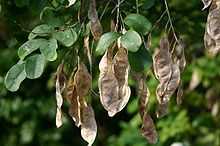Calpurnia (genus)
From Wikipedia, the free encyclopedia
| Calpurnia | |
|---|---|
 | |
| Inflorescence of C. sericea | |
 | |
| Foliage and seed pods of C. aurea | |
| Scientific classification | |
| Kingdom: | Plantae |
| (unranked): | Angiosperms |
| (unranked): | Eudicots |
| (unranked): | Rosids |
| Order: | Fabales |
| Family: | Fabaceae |
| Subfamily: | Faboideae |
| Tribe: | Podalyrieae |
| Genus: | Calpurnia E.Meyer |
| Species | |
|
See text. | |
Calpurnia is a genus of flowering plants within the family Fabaceae.
The genus comprises shrubs or small trees in or along the margin of forests in the eastern parts of South Africa. They shed leaves in winter unless in moist areas, where they are evergreen. They make good garden plants because they are easily raised from seed, flower at two years and withstand frost.
The species Calpurnia aurea is also known as Wild Laburnum / Wildegeelkeur. The bright yellow flowers have the typical form of the Fabaceae (pea family). They are borne in racemes and flowering can take place over several months. The flowers are visited by carpenter bees, after which the pollintated flowers turn into thin, straw-colored pods.
Species include:
- Calpurnia aurea
- Calpurnia aurea aurea
- Calpurnia aurea sylvatica
- Calpurnia capensis
- Calpurnia glabrata
- Calpurnia intrusa
- Calpurnia robinioides
- Calpurnia sericea
- Calpurnia villosa
- Calpurnia woodii
References
- Genera Containing Currently Accepted Names: Calpurnia via LegumeWeb
| Wikispecies has information related to: Calpurnia |
| Wikimedia Commons has media related to Calpurnia. |
This article is issued from Wikipedia. The text is available under the Creative Commons Attribution/Share Alike; additional terms may apply for the media files.